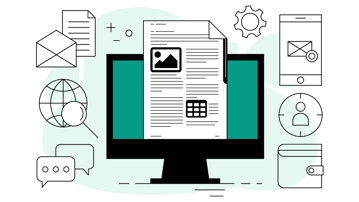Bid management is how companies create and send in winning proposals for contracts, also called tenders, RFPs (Requests for Proposal), and RFQs (Requests for Quotation). It helps companies win more often by giving them a clear plan and good control.
It's more than just writing papers. Successful bid management means you plan, work with others, and deliver correct, proper answers that meet what the client needs. It also means all your internal teams work together on a clear strategy. This is how businesses win contracts in tough industries and build long-term success.
Whether you're managing the bid process for a big project or responding to multiple bids across different sectors, effective bid management ensures every proposal is clear, timely, and convincing. The bid management process helps teams work closely across departments, reduces the risk of mistakes, and increases win rates.
What Bid Management Means and Where It's Used
Bid management is the complete process of bringing together people, tasks, information, and strategy essential for submitting proposals. It's especially important in industries where contracts are given out through formal processes, such as energy, construction, professional services, and advanced manufacturing.
A dedicated bid manager cam work with a group of different types team members, depending on the objective, ultimately orchestrating the entire bidding process. They ensure proposals meet deadlines, match what the client wants, and follow internal approval steps. This role becomes extra critical when organizations are managing multiple bids at the same time, or responding to very large and complex requests.
Effective bid management helps organizations to:
- Find and choose the right opportunities, making sure efforts focus on winnable bids.
- Get everyone on the same page about shared bidding strategies, fostering internal unity.
- Manage multiple contributors and deadlines efficiently, preventing delays.
- Ensure every proposal meets strict submission rules, lowering the chance of rejection.
- Show the company as a trustworthy and capable partner, building trust.
Why The Process Matters
A winning bid isn't solely about offering the lowest price. It shows you truly understand the client's needs, offer the best solution, and are confident you can deliver. Without a clear way to manage proposals, even highly experienced teams can struggle to compete effectively.
Poor planning in the bid management process often leads to:
- Missing submission deadlines, which instantly disqualifies the bid.
- Incomplete or messy answers, making the proposal less believable.
- Last-minute missing content or errors, showing a lack of care.
- Conflicting prices or delivery terms, causing confusion and mistrust.
These problems don't just hurt your chances on one project. They also harm client trust and can make future submissions less effective.
On the other hand, successful bid management makes things consistent, ensures you follow rules, and helps with continuous improvement. It lets your team submit proposals with accuracy and professionalism, every time.
Steps for a Successful Bid Management Approach
A well-organized bid management process usually has several main steps:
1. Finding Opportunities and Planning Ahead Winning begins long before a request comes in. Business development teams actively use tools, market info, and past bid schedules to see upcoming projects. Seeing these early helps companies get ready, build relationships, and gain an edge before the formal tender process even begins.
2. Deciding to Bid or Not Not every chance is worth chasing. Companies must carefully check if the client fits, if they can actually deliver, and how tough the competition is. This important "bid/no-bid" decision stops wasted effort and focuses energy on the most winnable and profitable opportunities.
3. Shaping Bidding Strategies and Starting Strong Once the decision to bid is made, key people work closely to plan the approach. This includes deciding on pricing, technical details, and what makes their offer special. A formal kickoff meeting is key for giving out tasks, confirming timelines, and establishing open communication, which sets up a smooth process.
4. Creating Content and Getting Input The bid manager can work to coordinate information from various departments, like experts, sales, legal, finance, and delivery teams. Teams work closely to create clear, correct, and convincing answers. Keeping track of changes (version control) and having one reliable place for information are crucial, especially when managing multiple bids simultaneously.
5. Reviewing and Improving the Proposal Strong bids go through many review stages. Early reviews check that everything lines up and is correct. Later reviews focus on the tone, rules, and overall clarity. This stage also includes checking prices and getting financial approvals.
6. Final Checks and Submission This vital step needs careful attention to detail. Formatting, file names, attachments, and specific submission rules must all be perfect. Bid management software can automate and double-check these steps. A professional, error-free submission tells evaluators you are reliable.
7. Post-Bid Reviews and Continuous Improvement After submission, experienced bid managers conduct thorough debriefs with the team. They analyze what worked well, identify bottlenecks, and pinpoint areas for continuous improvement. If client feedback is available, it's very useful for refining future proposals.
Suggested content



Key Bid Management Roles and Responsibilities
Every bid is a collaborative team effort. The specific bid management roles and their responsibilities can vary based on the bid's size, but a typical bid team might include:
- Bid Manager: The main person in charge. They handle the schedule, managing the bid process from start to finish, and making sure deadlines and rules are met.
- Subject Matter Experts (SMEs): Provide technical answers, examples, and specific content about the solution.
- Sales or Business Development: Offer client insights, make sure the offer fits business goals, and support the main plan.
- Legal and Finance: Check pricing, find possible risks, and review contract terms.
- Delivery or Operations Leads: Confirm that promises can actually be kept and that there are enough resources.
- Marketing or Proposal Designers: Focus on how the document looks, its design, and branding to show professionalism.
Whether proposal help comes from one central place or from different teams put together for each bid, clearly defining who does what is key to avoid confusion and repeated work.
How Software Helps You Win
Modern bid management software makes working together easier and greatly improves proposal quality. It replaces messy, separate ways of working with shared dashboards, strong change tracking, and automatic formatting.
Common features of such software include:
- Central task tracking and content storage, ensuring all information is easy to find.
- Access based on roles and content assignment, making it clear who is responsible for what.
- Real-time editing and review processes, facilitating seamless collaboration.
- Pre-approved templates and automated documents, cutting down on repetitive work and ensuring consistency.
These tools help teams manage multiple proposals at once, reduce manual effort, and maintain high standards for every submission.
What Makes a Competitive Bid?
Competitive bids share a few things in common:
- They directly answer all client needs, showing you paid attention.
- They clearly explain your solution and its benefits, making a compelling case.
- They show why your offer is better than competitors', highlighting unique value.
- They follow all formatting and structure instructions exactly, showing you are professional.
Beyond the words, a good visual layout, a consistent tone, and strong value points turn a regular answer into a winning bid.
Bid Management in Construction and Infrastructure
In industries like construction, energy, and transportation, proposals are often very long, technical, and heavily regulated. Bid teams in these areas must effectively manage:
- Information from many departments and subcontractors.
- Many layers of pricing models, risk lists, and detailed delivery plans.
- Strict rules for health, safety, and quality standards.
A planned, often software-supported, approach to bid management is vital for handling this complexity and reducing the chance of errors or omissions.
Final Submission and What Happens After the Bid
Sending in the bid isn't the end. It's part of a cycle of continuous improvement. After submission and post bids, effective bid management includes:
- Saving final documents for future use.
- Recording key facts, such as effort spent, outcome, and any client feedback.
- Debriefing internally and, if possible, with the client to learn more.
- Updating your content library and templates based on what you learned.
An experienced bid manager champions this cycle, ensuring that valuable insights gained from each opportunity help make future proposals stronger.
A Smart Way to Win More Work
Effective bid management isn't just a nice-to-have. It's a strategic capability that helps organizations grow, compete hard, and consistently win new business. By adding structure, clarity, and collaboration into every proposal effort, companies can:
- Improve the overall quality across multiple bids.
- Submit proposals faster, with far fewer mistakes.
- Align internal teams with minimal trouble.
- Significantly increase their chances of long-term success in competitive markets.
In today's competitive world, superior bid coordination isn't just about working efficiently—it's a real way to stand out. The companies that master this discipline are the ones that win contracts more, grow faster, and set themselves up for continued success.






